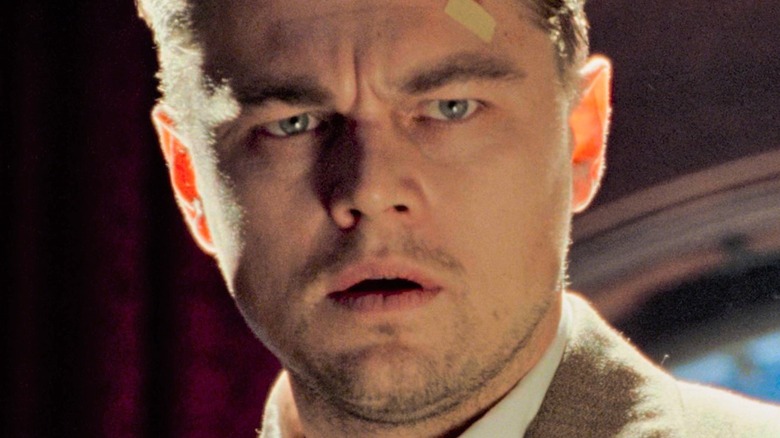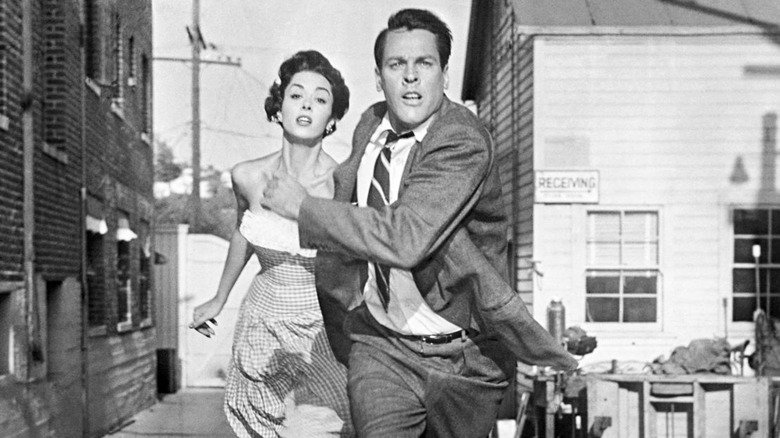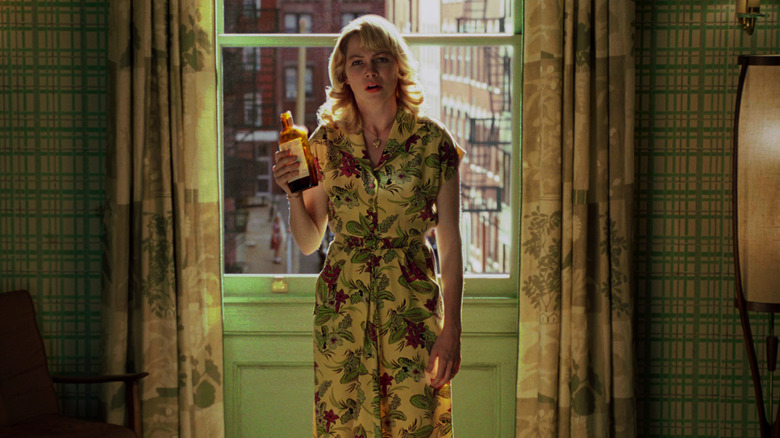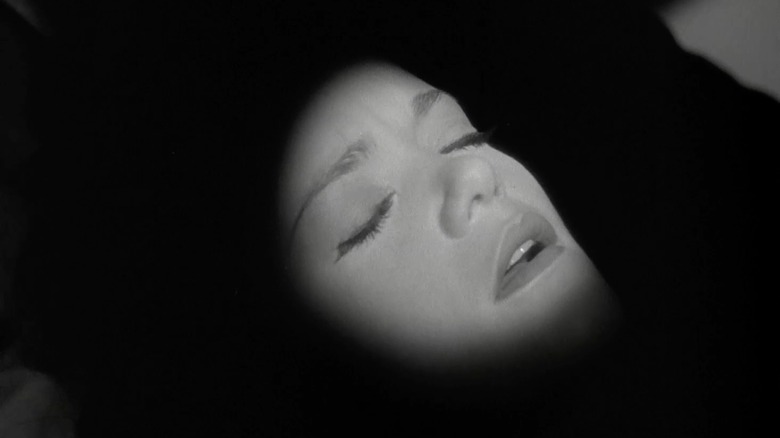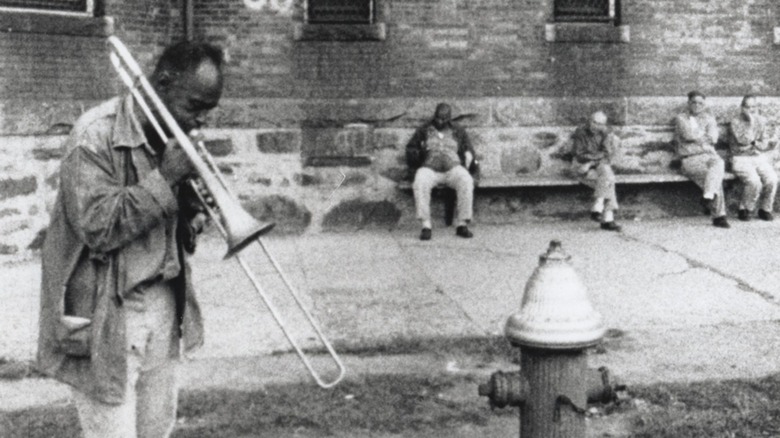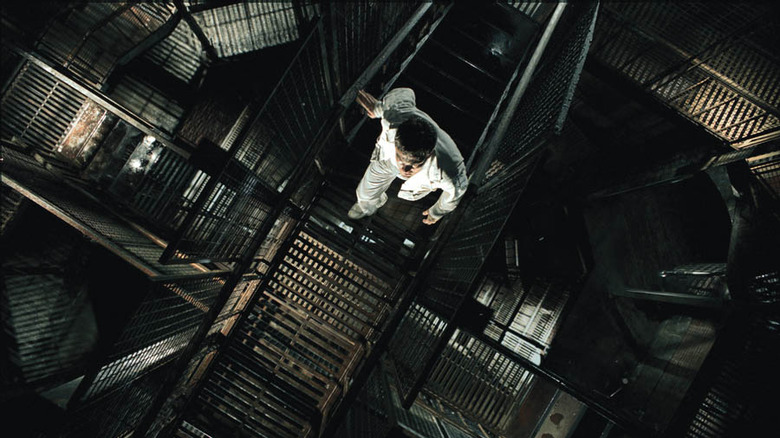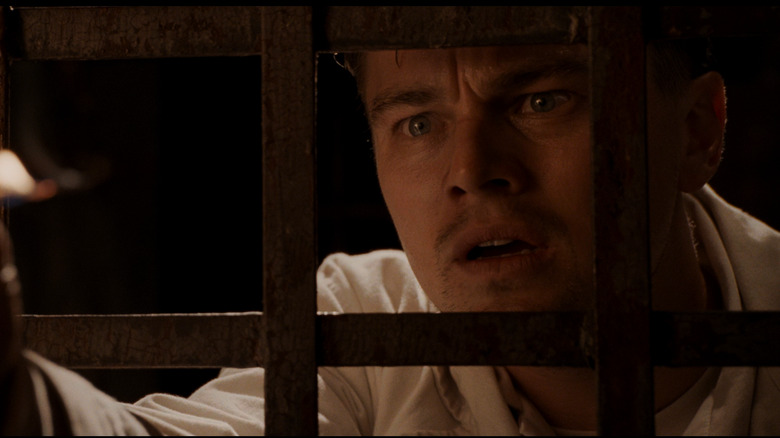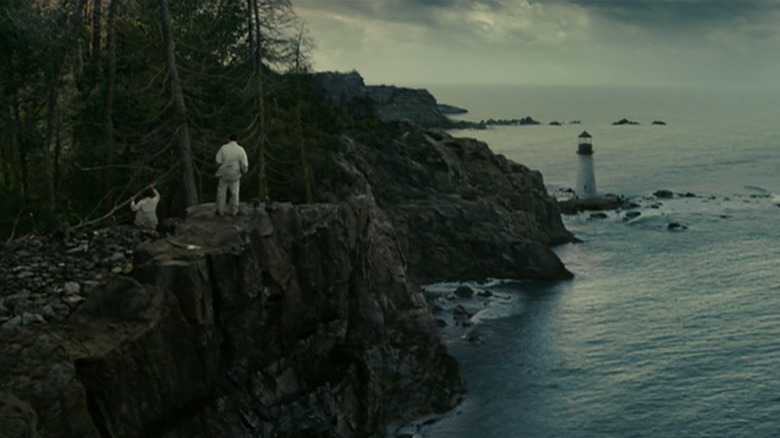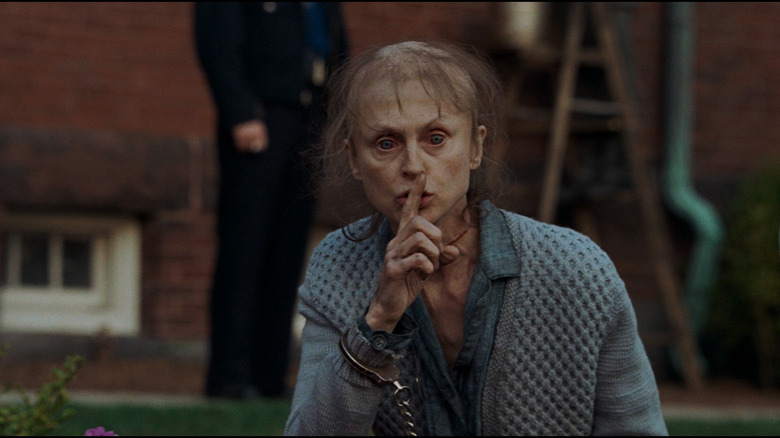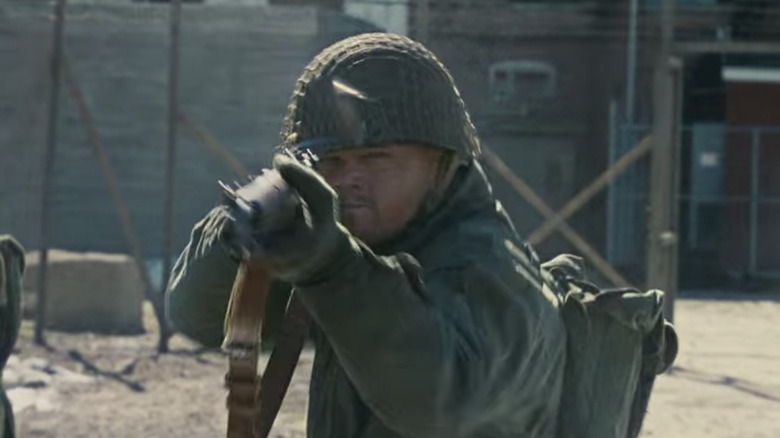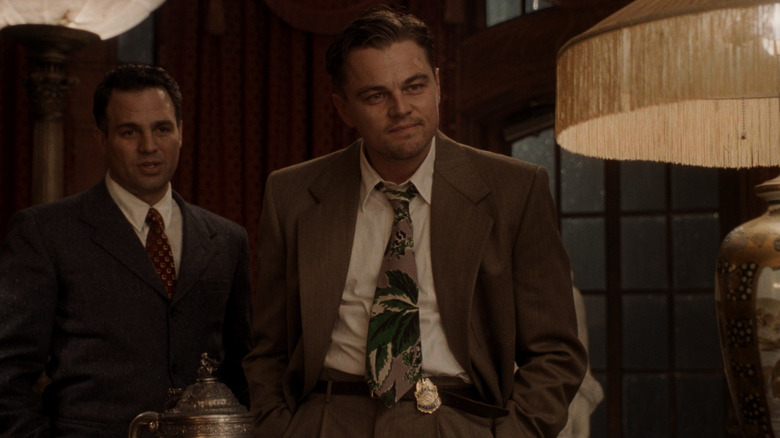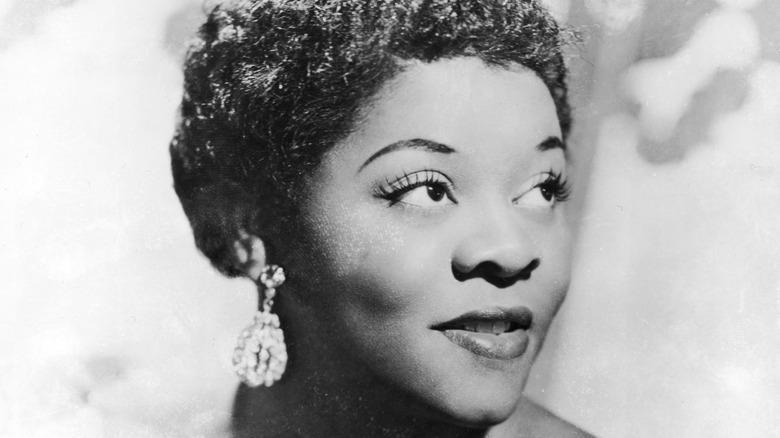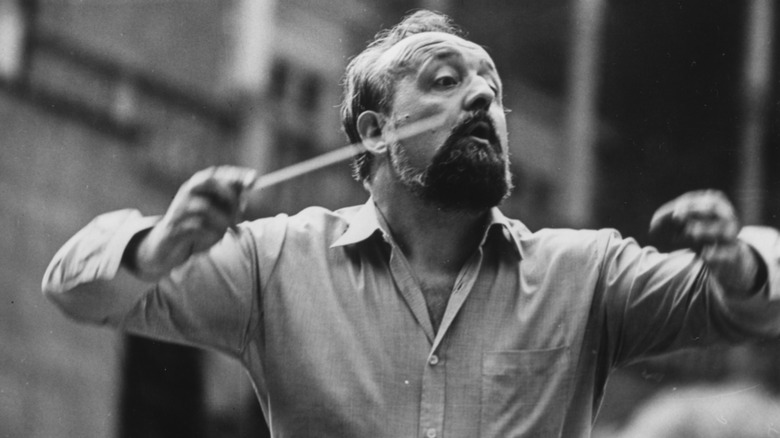The Untold Truth Of Shutter Island
Martin Scorsese has spent most of his career paying tribute to the directors who came before him. And at least as many younger directors have paid tribute to him. "Shutter Island" is something much more unexpected — an elder director taking cues from the younger generation he himself influenced. "Shutter Island" is Scorsese's contribution to the subgenre of slick, mind-bending thrillers that filmmakers like Christopher Nolan and David Fincher popularized in the '90s.
What could've been a sad spectacle of an old man trying to keep pace with a world that passed him by turned out to be just the opposite. Here, Scorsese shows the youngsters how it's done. Just as he did a few months later in Nolan's "Inception," Leonardo DiCaprio stars as a haunted man trying to untangle reality from fantasy. This time, it's 1954, and he's a federal marshal named Teddy Daniels, investigating the disappearance of Rachel Solando on Shutter Island, a maximum security hospital for the criminally insane. The doctors (Ben Kingsley and Max von Sydow) have some radical ideas about treatment, and it soon becomes less clear who belongs on which side of the bars.
Scorsese's journey to bring "Shutter Island" to theaters wasn't quite as harrowing as Teddy's, but it has its own share of surprising twists. Here are a few of the twistiest.
This article contains spoilers.
The book was based on movies before Scorsese made a movie based on the book
"Shutter Island" began with author Dennis Lehane in 2003. It was just one stop in a long and successful career that's brought him in and out of Hollywood multiple times. Clint Eastwood adapted his novel "Mystic River" into an Oscar-winning hit starring Sean Penn and Kevin Bacon. Two of Lehane's other novels — "Gone, Baby, Gone" and "The Drop" — were the basis for Ben Affleck's first movie as a director and James Gandolfini's last as an actor.
So it adds up that Lehane would have movies on the brain when he wrote "Shutter Island." He told the Wall Street Journal that after finding unexpected respectability with "Mystic River," he wanted to get back to his roots and write something that evoked classic pulp fiction and B-movies. He says he was especially inspired by the ones that combined horror and allegory, like "The Wicker Man" and "Invasion of the Body Snatchers."
Naturally, this film buffery appealed to the world's biggest film fan, Martin Scorsese, and the author discovered the director had even included references to movies Lehane hadn't even watched. Like the silent German classic "The Cabinet of Dr. Caligari," "Shutter Island" ends with the revelation that everything we've seen is a mental patient's delusion and the "villain" is actually his doctor. But when Scorsese asked Lehane about it, he was forced to admit he'd never seen it.
Scorsese signed on for Shutter Island in record time
For a director known for in-depth character studies and gangster flicks, a lowbrow thriller like "Shutter Island" might seem like a left-field choice. He'd never made a horror movie in his long career. The closest he'd come was an episode of the "Amazing Stories" anthology series and "Cape Fear," where he pumped up a film noir classic with extra horror elements.
"Shutter Island" had cycled through other, more conventional choices before it landed on Scorsese's desk. The New Humanist reports David Fincher had developed his own take on the project, and it seems like a natural fit for the director of grim, twist-filled thrillers like "Fight Club" and "Seven." Entertainment Weekly names Wolfgang Petersen, director of "Air Force One" and "The Neverending Story." We're not sure what either of them would have done with "Shutter Island" or what made Scorsese's producer think he was the man for the job, but Scorsese didn't have to think about it at all. He told EW, "I decided to make 'Shutter Island' literally the night I read the script."
Scorsese coordinated classic movie screenings to set the mood
Scorsese movies have always been grounded in the classics, whether he's transplanting Westerns like "The Searchers" to '70s New York in "Taxi Driver" or paying tribute to an early master in "Hugo." "Shutter Island" was no exception, and the horror elements gave Scorsese a chance to bring in a genre he'd rarely worked with but always loved. He told The Telegraph he discovered master horror producer Val Lewton when he was only 10. But Lewton classics like "I Walked with a Zombie" and "Cat People" and the producer's skill at suggesting unseen horrors made an impression that lasted all his life.
To get everybody on his wavelength, CNN reported that Scorsese organized screenings on the set, including "Cat People," director Jacques Tourneur's classic noir "Out of the Past," and cult exploitation director Sam Fuller's own portrayal of a nightmarish mental hospital in "Shock Corridor." These old movies became a useful shorthand for directing Scorsese's actors. To get at Teddy's shell-shocked, no-nonsense attitude, Scorsese told The Telegraph, "The key film I showed Leo and Mark was 'Laura.' Dana Andrews, the way he wears his tie, and the way he walks through a room, and he doesn't even look at anybody; he's always playing that little game."
A classic documentary inspired Shutter Island
"Conversations with Scorsese," the director tells Richard Schickel that "Titicut Follies" was a major influence on "Shutter Island." "Follies" was the debut of pioneering documentarian Frederick Wiseman, who used his camera to expose the conditions in Bridgewater State Hospital in 1967. The results were hugely influential, maybe more so than Wiseman could've predicted. The film led to a major legal battle, with the state of Massachusetts claiming the shockingly candid footage violated the patients' privacy, but it doesn't take a genius to see the state may have been more concerned about its abuse of those patients being widely seen.
Scorsese was one of the few who got to see "Titicut Follies," and it left a deep impression. "I didn't have to see it again. I knew it very well." And that influence is visible on-screen, with the director explaining, "In fact, there are moments that the actors took directly from 'Titicut Follies.'"
The events of "Titicut Follies" had a more direct connection to "Shutter Island" as well. Dr. James Gilligan served as the psychological advisor on "Shutter Island," and years before, he'd worked to dismantle the abusive system at Bridgewater that Wiseman chronicled. He can vouch for the film's authenticity. As Scorsese said, "He pointed out that Ward C is actually a smaller version of the places he knew at Bridgewater. Pretty horrifying."
Scorsese shot the film in a real mental hospital
Adding to the authenticity, Scorsese found a location where the events of "Shutter Island" could've actually taken place in the '50s. He took his crew to Medfield State Hospital in Massachusetts, once a site for the kind of treatment the patients receive in "Shutter Island" but long abandoned by the time the filmmakers got there. It was the perfect place to bring this dark story to life. Scorsese said (via EW), "The peeling paint, the floorboards breaking underneath your feet, the old pieces of equipment laying around — the place reeked of suffering."
His description to Richard Schickel is even more vivid. "You could feel, from the walls, the pain and the suffering that it contained." Even all the bustle and action of a major Hollywood production couldn't cut through the atmosphere. "You can have all the people you want running around, you can have all the coffee and all the crafts services tables, it doesn't matter. If you have any feeling, you want to get out of there."
The Shutter Island set was literally out of DiCaprio's nightmares
If the "Shutter Island" set was disturbing to Scorsese, it affected star Leonardo DiCaprio even more deeply. He told Entertainment Weekly, "We went to some pretty hardcore places during the filming of this movie. And not just where we shot it but emotionally and psychologically. We didn't pull any punches."
Another interview with Parade makes it clear he wasn't exaggerating. If anything, he was understating the difficulty of the shoot. "It was really very traumatic, and I don't say that about a film very often. I went to places and unearthed some things that I didn't think I was capable of. ... It took me back to the one time I really remembered my dreams because I usually don't. But when I used a nicotine patch when I was trying to quit smoking, I did have bloodcurdling nightmares of mass murders, and I woke up in the middle of the night and had to take the patches off. I guess I had moments like that in the film."
You could forgive DiCaprio if he never wanted to have anything to do with anyone who'd put him through that ever again, but that's far from the case. He and Scorsese would make "The Wolf of Wall Street" together three years later, and as of this writing, the two of them are filming "Killers of the Flower Moon," bringing their total number of collaborations up to six.
The movie forced its elderly director to climb a cliff at 7 AM
The "Shutter Island" shoot could be just as demanding physically as it was psychologically. The movie features a lot of bleak, rocky settings to help set the ominous mood. And they're not just for looks either. They separate the main island from the lighthouse where inhuman experiments may or may not be taking place. And in a cave on the sheer cliff face, Teddy meets a woman (Patricia Clarkson) who claims to be the real Rachel Solando, a psychologist who was committed by her peers when she discovered their terrible secrets.
Not just any cliff will do for scenes like this, so "Shutter Island" required extensive location scouting. And even though Scorsese was nearly 70 when he made the film, he still took a hands-on approach to the process. A piece by CNN opens with him scaling the rocks at 7 AM. That's a tall order for any senior citizen, but even more so for Scorsese, who's suffered from asthma since childhood. That illness kept him cooped at home in front of the TV a lot as a child, inspiring his love of movies and his eventual career making his own. Who would've thought that avoiding exertion as a child would lead him to exert himself this much decades later?
Scorsese drew from childhood memories for his portrayal of mental illness
There's room for a profitable debate over how "Shutter Island" uses insanity as fodder for horror. But whatever it may or may not do to stigmatize and sensationalize mental illness, a major part of that horror comes from just how accurate its portrayal is. That's because Scorsese had firsthand experience as a child that's been burned into his brain even after all this time.
Before he made "Mean Streets," Scorsese lived it, growing up poor in New York's Little Italy. This gave him firsthand experience with the gangster characters who appear in "Goodfellas" and "The Irishman," but he finds the roots of "Shutter Island" in those memories too. "I grew up among homeless people in the Bowery, just a few blocks away," he told critic Richard Schickel. "They hear voices and the voices tell them to do something because the voices tell them to do something. They go and kill children because the voices tell them to." That's the kind of experience you never forget, and you can see its influence all over "Shutter Island."
Teddy participated in a real massacre
One of the most frightening things in "Shutter Island" is the sense that the outside world is even more disturbed than anything going on behind the hospital walls. That sense is especially palpable in the flashes we get of Teddy's experience in World War II. We eventually get a full view of just what happened, and it's deeply horrifying.
Serving in the European theater, Teddy discovers the Nazi concentration camp in Dachau, where frozen bodies are left piled in heaps like garbage. These soldiers aren't prepared for the horror they witness, and they respond by committing a horror of their own, lining up the unarmed SS officers and mowing them down. "It wasn't war," Teddy says. "It was murder."
This scene is even more disturbing when you know it actually happened. The soldiers involved were court-martialed, and their trial is all on record. But the horror of Dachau may have been too much even for the U.S. military because those records were suppressed until 1991, just over a decade before Dennis Lehane fictionalized the incident in his novel.
Shutter Island is full of purposeful mistakes
If a movie does its job right, you'll believe everything you see really unfolded just the way it's shown to you. But the reality is often very different. Movies are cut together from multiple takes, and moments that seem to take place all at once could be filmed months or even years apart. Most filmmakers hide the seams through what they call "continuity," making sure every shot is consistent with each other.
But if you're watching "Shutter Island" closely, you'll see it breaks those rules. When Teddy meets with Dr. Cawley (Kingsley), his glass of soda teleports from his hand to the table between shots. And when Teddy interrogates a prisoner named George Noyce (Jackie Earle Haley), George has his hand on his head when we see him head-on, but it disappears when we see him from behind. Plus, there's a cigarette that lights itself between cuts.
"Shutter Island" is edited by Thelma Schoonmaker, who's worked with Scorsese his entire career and won three Oscars — not the kind of person you'd expect to make mistakes. And from that perspective, it's clear all these mistakes serve a purpose. Most movies avoid continuity errors because they remind us what we see isn't real. But in a movie where reality's up in the air as "Shutter Island," that's exactly what we need to remember. Just look at what's going on in that scene with Noyce's disappearing hand — he's telling Teddy he's fallen for a fiction, just the way we have in the audience.
The credits combine a classical composer, a soul diva, and a rock star
The most devastating moment in "Shutter Island" isn't really part of the movie itself, depending on how you reckon it. It's the achingly sad song that plays over the credits, just as viewers are already leaving the theater. It took the work of many musicians from different fields, who may have never even met each other, but their work comes together to create something beautiful.
The vocals are from Dinah Washington's 1960 single "This Bitter Earth." Washington was in her prime when she cut that track, but she'd already been performing for almost 20 years in a career that encompassed soul, blues, jazz, pop, and gospel, including the smash hit "What a Diff'rence a Day Makes."
The instrumental comes from a wildly different source. It comes from classical composer Max Richter's "On the Nature of Daylight," part of his 2004 suite "The Blue Notebooks." His other work ranges from the eight-hour "Sleep," performed in venues full of beds, to original movie to TV scores, including "Waltz with Bashir" and "Black Mirror."
Mixing the two together is Robbie Robertson, former frontman of the Band. After a successful career that saw the group tour with Bob Dylan and record classics like "Forever Young" and "The Weight," Robertson brought in Scorsese to document the Band's final concert in "The Last Waltz." That was the end of the Band but the beginning of another long-lasting relationship, and Scorsese and Robertson have continued collaborating ever since.
The soundtrack is taken from avant-garde classical classics
A major part of Scorsese's distinctive style is his soundtracks of wall-to-wall pop and rock classics, often coordinated by musician Robbie Robertson. The duo do something similar but very different in "Shutter Island." They could've composed the kind of droning, dissonant score favored by so many horror filmmakers. But instead, they go straight to the source, collecting music from the musical pioneers who discovered those sounds before they became acceptable enough for mass media fodder.
"Shutter Island" opens with "Fog Tropes," an Ingram Marshall composition combining classical music with field recordings of foghorns, wind, and other environmental noise. Those creepy sped-up and spliced-together noises that underscore Teddy's first Dachau flashback come from Nam June Paik's tape experiment "Homage to John Cage" — a clever period-appropriate equivalent to the digitally distorted noises other horror filmmakers like to use. John Cage himself contributes "Music for Marcel Duchamp" — already a movie score for a film by the famous Dada artist — and "Roots of an Unfocus."
The most prevalent cue, with those thrumming, low notes that descend into high-pitched madness and martial drums, come from Krzysztof Penderecki's Symphony No. 3. The Dachau scene features Gustav Mahler's Piano Quartet — a fitting choice since he's been described as the forerunner of the Modernist music from the rest of the soundtrack and was a victim of pre-Nazi anti-Semitism. Other scenes feature rock producer and ambient music pioneer Brian Eno, opera experimenter John Adams, and a who's who of the musical avant garde from the 19th century to now.
